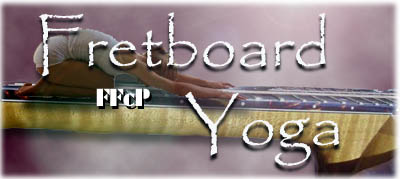« Not a Ukulele. |
Main
| Seven Days: Will Patton Ensemble review »
 February 9, 2015 | Warm-ups? FFcP, of course! February 9, 2015 | Warm-ups? FFcP, of course!

Athletes start their workouts with calisthenics, and you need to consider playing mandolin in the same physical context--warming up to get limber and build fretboard strength and facility. So what if you could build fingers and mind at the same time?
This is the beautiful thing about something we call FFcP. It's a whole system of mastering the frets, but taking on music theory in the same way. Consider the following from our introductory FFcP notes.
Four Finger Closed Position FFcP
Jazz theory is based on tone relationships. Initially, how chords and scale tones interact, stray, resolve, move, can be overwhelming! We will attempt to debunk the notion that the "mystery" and complexity of jazz can only be unlocked by a privileged few. The virtually infinite combinations within 12 keys can easily be reduced and understood, by adopting the Four Finger Closed Position system (FFcP).
Give this a try - at first it will work some muscles you never knew existed. But they are important for a complete musician. Try it for a month - then keep on doing it.
Let's look at the first position possibilities. We'll start with the first finger position in the key of A. Note that if you move it down one fret, you come up with the key of Ab. Tone relationships remain intact, as well as fingerings. Now move it up one string, you have the key of Eb, without learning a new pattern. All your scale degree FUNCTIONS are covered by the same fingers. And if you move this up a fret to, you get the key of E. You now have 4 of the 12 major scales, with only one fingering pattern.
We aren't going to completely drop open strings! But for the purpose of simplifying and reducing the unwieldy amount of options, at this time, we're going to build a tactile "home base," to aid in visualizing harmonic function on the fingerboard and "feel" the relationship of common "modes", to the frets.
First, we need to limit the fingering to just four possibilities. As you study these, understand we are building roadmaps, or better, "wagon trail ruts" of where to intuitively place your fingers during improvisation. Along the way, you'll enjoy the healthy by-product of a useful, limber 4th finger (pinky). And eventually abandon the fear of moving everything up the frets into the fertile potential of the mandolin's higher positions.
We'll also gain skill in identifying which notes are critical in defining tonality and creating tension and resolution.
1st FFcP
A, Ab, E, Eb |  |  |
 |
 |
| Starting point... | Down one fret | Up one string! | Up one fret. |
Keep going: FFcP Studies
Posted by Ted at February 9, 2015 9:37 PM

Disclaimer: In the 'Information Age' of the 21st Century,
any fool with a computer, a modem, and an idea can
become a self-professed 'expert." This site does not
come equipped with 'discernment.'
|



